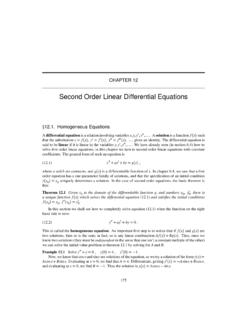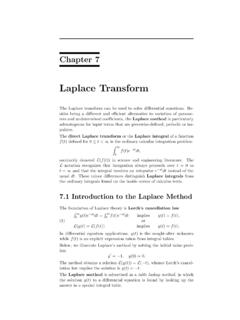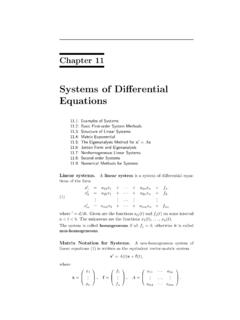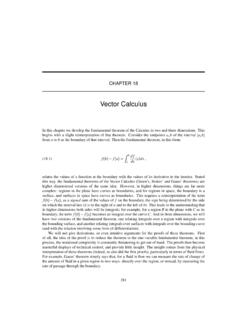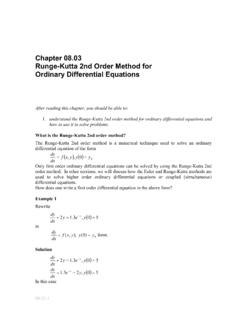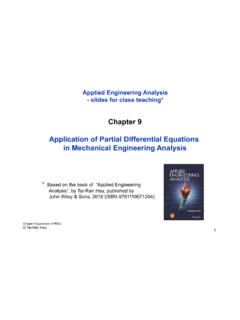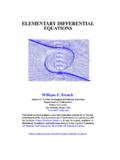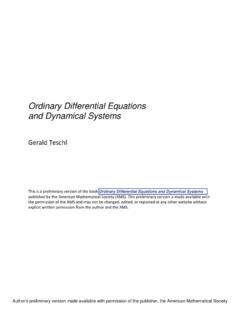Transcription of Theory of Ordinary Differential Equations
1 Theory of Ordinary Differential EquationsTheory of Ordinary Differential EquationsCHRISTOPHERP. GRANTB righam Young UniversityContentsContentsi1 Fundamental and Dynamical Systems .. of Solutions .. of Solutions .. of Theorem .. of Existence .. on Parameters ..182 Linear Coefficient Linear Equations .. the Matrix Exponential .. Eigenspace Decomposition .. on Generalized Eigenspaces .. Canonical Form .. Linear Systems .. Behavior of Linear Systems .. Decay .. Linear Systems .. Nearly Autonomous Linear Systems .. Periodic Linear Systems ..593 Topological Sets and Limit Sets .. and Singular Points .. of Stability .. of Linearized Stability .. s Direct Method .. s Invariance Principle.
2 Theorem: Part 1 .. Theorem: Part 2 .. Theorem: Part 3 .. Theorem: Part 4 .. Theorem: Part 5 .. Conjugacies .. Conjugacies .. 1075 Invariant Manifold Theorem: Part 1 .. Manifold Theorem: Part 2 .. Manifold Theorem: Part 3 .. Manifold Theorem: Part 4 .. Manifold Theorem: Part 5 .. Manifold Theorem: Part 6 .. Manifolds .. and Using Center Manifolds .. 1346 Periodic e-Bendixson Theorem .. s Equation .. s Theorem .. 147ii1 Fundamental ODEs and Dynamical SystemsOrdinary Differential EquationsAn Ordinary Differential equation (or ODE) is an equation involving derivativesof an unknown quantity with respect to a single variable. More precisely, supposej;n2N,Eis a Euclidean space, R nC1copies.
3 E E!Rj:( )Then annth order Ordinary Differential equationis an equation of the ; ; ; ; ; ; :( )IfI Ris an interval, thenxWI!Eis said to bea solution of( )onIifxhas derivatives up to ordernat everyt2I, and those derivatives satisfy ( ).Often, we will use notation that suppresses the dependence ofxont. Also, therewill often be side conditions given that narrow down the set of solutions. In thesenotes, we will concentrate oninitial conditionswhich prescribex.`/.t0/for somefixedt02R(called theinitial time) and some choices of`2f0;1;:::;ng. SomeODE texts examinetwo-point boundary-value problems, in which the value of afunction and its derivatives at two different points are required to satisfy givenalgebraic Equations , but we won t focus on them in this FUNDAMENTALTHEORYF irst- order EquationsEvery ODE can be transformed into an equivalent first- order equation.
4 In partic-ular, givenxWI!E, suppose we definey1 WDxy2WD Pxy3WD 1/;and letyWI!Enbe defined ;:::;yn/. ForiD1;2;:::;n 1,defineGiWR En En! ;u;p/WDp1 ;u;p/WDp2 ;u;p/WDp3 u4:::Gn ;u;p/WDpn 1 un;and, givenFas in ( ), R En En! ;u; ;u1;:::;un;pn/; .t;u;p/2R En En .t;u1;:::;un; R En En!En 1 Rjbe defined byGWD0 BBBBB@G1G2G3:::Gn1 CCCCCA;we see thatxsatisfies ( ) if and only ; ; and Dynamical SystemsEquations Resolved with Respect to the DerivativeConsider the first- order initial-value problem (or IVP)8 < ;x; ;( ) R Rn Rn!Rn, andx0;p0are given elements ;x0;p0/D0. The Implicit Function Theorem says that typicallythe ;x;p/of the (algebraic) ;x; ;x0;p0/form surface that can be parametrized ;x/. In otherwords, locally the ;x;p/D0is equivalent to an equation of ;x/for / R Rn!
5 ;x0/in theinterior of /. Using thisf, ( ) is locally equivalent to the IVP( ; :Autonomous / R Rn!Rn. The ;x/( )isautonomousiffdoesn t really depend ont, , if /DR for some Rnand there is a functiongW !Rnsuch ; everyt2 Rand everyu2 .Every nonautonomous ODE is actually equivalent to an autonomous see why this is so, givenxWR!Rn, defineyWR! ; ;:::; , and / R Rn!Rn, define a / RnC1!RnC1byQf /D p2 RnC1 .p1;.p2;:::;pnC1 / :Thenxsatisfies ( ) if and only ifysatisfiesPyDQf .y/.31. FUNDAMENTALTHEORYB ecause of the discussion above, we will focus our study on first- order au-tonomous ODEs that are resolved with respect to the derivative. This decisionis not completely without loss of generality, because by converting other sortsof ODEs into equivalent ones of this form, we may be neglecting some specialstructure that might be useful for us to consider.)
6 This trade-off between abstract-ness and specificity is one that you will encounter (and have probably alreadyencountered) in other areas of mathematics. Sometimes, when transforming theequation would involve too great a loss of information, we ll specifically studyhigher- order and/or nonautonomous SystemsAs we shall see, by placing conditions on the functionfW Rn!Rnandthe pointx02 we can guarantee that the autonomous IVP( ( )has a solution defined on some intervalIcontaining0in its interior, and this so-lution will be unique (up to restriction or extension). Furthermore, it is possibleto splice together solutions of ( ) in a natural way, and, in fact, get solu-tions to IVPs with different initial times. These considerations lead us to study astructure known as adynamical Rn, a continuous dynamical system (or aflow) on is a function'WR !)
7 Satisfying:1.'.0;x/Dxfor everyx2 ;2.'.s;'.t;x//D'.sCt;x/for everyx2 and everys;t2R;3.'is are sufficiently nice we will be able to define a function'WR ! by letting'. ;x0/be the unique solution of ( ), and this defi-nition will make'a dynamical system. Conversely, any continuous dynamicalsystem'.t;x/that is differentiable with respect totis generated by an 1 Suppose that: Rn;4 ODEs and Dynamical Systems 'WR ! is a continuous dynamical system; @texists for everyt2 Rand everyx2 ; x02 is given; yWR! is defined '.t;x0/; fW !Rnis defined @s thatysolves the IVP( :In these notes we will also discussdiscrete dynamical systems. Given Rn, a discrete dynamical system on is a function'WZ ! satisfying:1.'.0;x/Dxfor everyx2 ;2.)
8 '.`;'.m;x//D'.`Cm;x/for everyx2 and every`;m2Z;3.'is is a one-to-one correspondence between discrete dynamical systems'andhomeomorphisms(continuous functions with continuous inverses)FW ! ,this correspondence being given by'.1; /DF. If we relax the requirement ofinvertibility and take a (possibly noninvertible) continuous functionFW ! and define'Wf0;1;:::g ! by'.n;x/Dncopies .. //;then'will almost meet the requirements to be a dynamical system, the onlyexception being that property 2, known as thegroup propertymay fail because'.n;x/is not even defined forn < 0. We may still call this a dynamical system;if we re being careful we may call it asemidynamical a dynamical system, the set is called thephase space. Dynamical sys-tems are used to describe the evolution of physical systems in which the stateof the system at some future time depends only on the initial state of the sys-tem and on the elapsed time.
9 As an example, Newtonian mechanics permits us51. FUNDAMENTALTHEORYto view the earth-moon-sun system as a dynamical system, butthe phase spaceis not physical spaceR3, but is instead an 18-dimensional Euclidean space inwhich the coordinates of each point reflect the position and momentum of eachof the three objects. (Why isn t a 9-dimensional space, corresponding to the threespatial coordinates of the three objects, sufficient?) Existence of SolutionsApproximate SolutionsConsider the IVP( ; ;( ) / R Rn!Rnis continuous, ; /isconstant. The Fundamental Theorem of Calculus implies that( ) is equivalentto the integral ; :( )How does one go about proving that ( ) has a solution if, unlike the casewith so many IVPs studied in introductory courses, a formulafor a solution can-not be found?)
10 One idea is to construct a sequence of approximate solutions,with the approximations becoming better and better, in somesense, as we movealong the sequence. If we can show that this sequence, or a subsequence, con-verges to something, that limit might be an exact way of constructing approximate solutions isPicard iteration. Here, weplug an initial guess in forxon the right-hand side of ( ), take the resultingvalue of the left-hand side and plug that in forxagain, etc. More precisely, wecan recursively definexkC1in terms ofxkfork > ; :Note that if, for somek,xkDxkC1then we have found a approach is to construct aTonelli sequence. For eachk2N, defined < :a;ift0 t t0C1=kaCZt 1= ; ;ift t0C1=k( )6 Existence of Solutionsfort t0, and fort will use the Tonelli sequence to show that ( ) (and therefore ( )) has asolution, and will use Picard iterates to show that, under anadditional hypothesisonf, the solution of ( ) is the first result, we will need the following definitions and sequence of functionsgkWU R!

